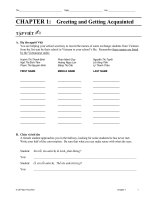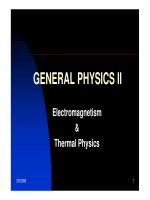Tài liệu Chapter 8B: Systematic Treatment of Equilibriu docx
Bạn đang xem bản rút gọn của tài liệu. Xem và tải ngay bản đầy đủ của tài liệu tại đây (100.68 KB, 39 trang )
Chapter 8B:
Systematic Treatment of Equilibrium
I. Introduction
¾Concentrations of individual species
¾Determining which species are present
¾Reactions
¾Equations
¾Steps in Figure 9-1
Example 9-1
¾ BaSO
4
(s) <=> Ba
2+
+ SO
4
2-
¾ 2H
2
O <=> H
3
O
+
+ OH
-
¾ SO
4
2 -
+ H
3
O
+
<=> HSO
4
-
+ H
2
O
¾HCl + H
2
O <=> H
3
O
+
+ Cl
-
I. Introduction
¾Concentrations of individual species
¾Determining which species are present
¾Reactions
¾Equations
¾Assumption
¾Steps in Figure 9-1
A Systematic Method
II. A Systematic Method
for Solving Multiple Equilibria Problems
¾Equilibrium-constant expressions
¾Mass (concentration)-balance equations
¾A single charge-balance equation
Mass (concentration)-balance equations
¾Equilibrium concentrations of various species
in a solution to one another and to the analytical
concentration
¾Two Steps:
¾Reactions
¾Equations
Example 9-1:
Write mass-balance expressions for a 0.0100 M solution of HCl that is in
equilibrium with an excess of solid BaSO
4
(s).
¾ BaSO
4
(s) <=> Ba
2+
+ SO
4
2-
¾ HCl + H
2
O <=> H
3
O
+
+Cl
-
¾ 2H
2
O <=> H
3
O
+
+ OH
-
¾ SO
4
2 -
+ H
3
O
+
<=> HSO
4
-
+ H
2
O
[Ba
2+
] = [SO
4
2 -
] + [HSO
4
-
]
[H
3
O
+
] = [Cl
-
]+[OH
-
]-[HSO
4
-
] = C
HCl
+ [OH
-
] - [HSO
4
-
]
=0.0100 +[OH
-
] - [HSO
4
-
]
[Cl
-
] = C
HCl
Example 9-2:
Write mass-balance expressions for the system formed
when a 0.010 M NH
3
solution is saturated with AgBr.
¾ AgBr (s) <=> Ag
+
+ Br
-
[1]
¾ Ag
+
+ 2NH
3
<=> [Ag(NH
3
)
2
]
+
[2]
¾ NH
3
+H
2
O <=> NH
4
+
+ OH
-
[3]
¾ 2H
2
O <=> H
3
O
+
+ OH
-
[4]
[Br
-
] = [Ag
+
] + [[Ag(NH
3
)
2
]
+
]
C
NH3 =
[NH
3
] + [NH
4
+
] + 2[[Ag(NH
3
)
2
]
+
] = 0.010 M
[
OH
-
] = [NH
4
+
] + [H
3
O
+
]
A single charge-balance equation
¾Solutions are neutral
¾ The Sum of molar concentration of positive charge =
The sum of molar concentration of negative charge
¾Concentration of charge by an ion =
molar concentration of that ion x its charge
¾Steps:
¾List all ions in the solution and their charges and
concentrations
¾ The Sum of molar concentration of positive charge =
The sum of molar concentration of negative charge
Example 9-1:
Write a charge-balance equation for a 0.0100 M solution of HCl
that is in equilibrium with an excess of solid BaSO
4
(s).
¾ BaSO
4
(s) <=> Ba
2+
+ SO
4
2-
¾ HCl + H
2
O <=> H
3
O
+
+Cl
-
¾ 2H
2
O <=> H
3
O
+
+ OH
-
¾ SO
4
2 -
+ H
3
O
+
<=> HSO
4
-
+ H
2
O
2[Ba
2+
] +[H
3
O
+
] = 2[SO
4
2 -
]+[HSO
4
-
]+[OH
-
] + [Cl
-
]
Example 9-2:
Write a charge-balance equation for the system formed
when a 0.010 M NH
3
solution is saturated with AgBr.
¾ AgBr (s) <=> Ag
+
+ Br
-
[1]
¾ Ag
+
+ 2NH
3
<=> [Ag(NH
3
)
2
]
+
[2]
¾ NH
3
+H
2
O <=> NH
4
+
+ OH
-
[3]
¾ 2H
2
O <=> H
3
O
+
+ OH
-
[4]
[Ag
+
] + [[Ag(NH
3
)
2
]
+
] + [NH
4
+
] + [H
3
O
+
] =[OH
-
] + [Br
-
]
Example 9-3:
Write a charge-balance equation for a 0.100 M solution of
NaCl
¾NaCl Na
+
+ Cl
-
¾2H
2
O <=> H
3
O
+
+ OH
-
<=>
[
Na
+
] +[H
3
O
+
] = [Cl
-
] + [OH
-
]
0.100 + 10
-7
= 0.100 + 10
-7
Example 9-4:
Write a charge-balance equation for a 0.100 M solution of
MgCl
2
¾MgCl
2
<==> Mg
2+
+ 2Cl
-
¾2H
2
O <=> H
3
O
+
+ OH
-
2[Mg
2+
] +[H
3
O
+
] = [Cl
-
] + [OH
-
]
2 x 0.100 + 10
-7
= 0.200 + 10
-7
A Systematic Method
Steps for solving problems involving multiple equilibria
¾Pertinent Equilibria
¾The definition of unknown
¾Equilibrium Constant Expressions
¾Mass balance equation
¾Charge balance equation
¾Check No. of unknown species concentrations
and No of independent equations
¾Approximations:
¾Check of assumptions
¾Calculate unknown concentrations
III
.
C
a
l
cu
l
a
ti
on o
f
S
o
l
u
bilit
y
b
y
th
e
S
ys
t
ema
ti
c
Method
¾Metal Hydroxides (Examples 9-5)
¾The effect of pH on solubility
(1) pH is fixed (Example 9-6)
(2) pH is variable or unknown
(Examples 9-7)
¾Formation of Complex Ion
(Examples 9-8)
¾Separation of ions
(Examples 9-9)
¾Metal Hydroxides: Example 9-5:
Calculate the molar solubility of Fe(OH)
3
in water.
1. Pertinent Equilibria:
Fe(OH)
3
(s) <===> Fe
+3
+ 3 OH
-
2 H
2
O (l) <====> H
3
O
+
+ OH
-
2. The definition of unknown:
Molar solubility Fe(OH)
3
= [Fe
+3
]
3. Equilibrium Constant Expressions
K
sp
=[Fe
+3
][OH
-
]
3
= 2 x 10
-39
[Eq 1]
K
w
=[H
3
O
+
][OH
-
] = 1 x 10
-14
[Eq 2]
4. Mass balance equation
[H
3
O
+
] + 3[Fe
+3
] = [OH
-
] [Eq 3]
5. Charge balance equation
[H
3
O
+
] + 3[Fe
+3
] = [OH
-
] [Eq 4]
6. 3
chemical species ([Fe
+3
], [OH
-
], [H
3
O
+
])
3
independent equations
7. Approximations:
First assume [H
3
O
+
] << 3[Fe
+3
]
Then Eq 3: [H
3
O
+
] + 3[Fe
+3
] = [OH
-
] becomes
3[Fe
+3
] = [OH
-
]
substituting [OH
-
] = 3[Fe
+3
] into Eq. 1:
[Fe
+3
][OH
-
]
3
= K
sp
= 2 x 10
-39
27 {[Fe
+3
]}
4
= 2 x 10
-39
[Fe
+3
] = 9 x 10
-11
M molar solubility
8. Check of assumptions:
Our assumption for Eq 3 was
[OH
-
] = 3[Fe
+3
]
[OH
-
] = 3(9 x 10
-11
) = 3 x 10
-10
[]
]
HO
K
[OH
M
3
+
w
-
== =
−
−
−
110
310
310
14
11
5
x
x
x
3 x 10
-5
is not less than 3 x 10
-10
so that
actually 3[Fe
+3
] << [H
3
O
+
] and Eq 3 becomes
[H
3
O
+
] = [OH
-
] = 1 x 10
-7
9. Substituting this value for the [OH
-
] is Eq 1
[]
]( )
Fe
K
[OH
M
3+
sp
-
== =
−
−
−
3
39
73
18
210
110
210
x
x
x
The effect of the sel
f
-ionization of water is
significant for relatively insoluble metal hydroxides
This is an example of the common ion effect
!!!
In conclusion :
Any Questions?
¾The effect of pH on solubility: (a) pH is fixed (known)
Example 9-6: Calculate the molar solubility of PbCO
3
in a solution
buffered to a pH of 7.00.
1. Pertinent equilibria:
PbCO
3
<=> Pb
+2
+ CO
3
-2
K
sp
H
2
CO
3
+ H
2
O <=> HCO
3
-
+ H
3
O
+
K
a1
HCO
3
-
+ H
2
O <=> CO
3
-2
+ H
3
O
+
K
a2
2. Definition of unknown: Solubility = [Pb
+2
]
3. Equilibrium Expressions
K
sp
=[Pb
+2
][CO
3
-2
] = 7.4 X 10
-14
K
[H O HCO
HCO
a1
3
+
3
-
23
==
−
][ ]
[]
.445 10
7
x
4. Mass Balance Equation
[Pb
+2
] = [CO
3
-2
] + [HCO
3
-
] + [H
2
CO
3
]
5. Charge balance equation cannot be determined
because the buffer species have not been given,
6. Unknowns are [Pb
+2
], [CO
3
-2
], [HCO
3
-
], [H
2
CO
3
].
Four independent equations and four unknowns.
K
[H O CO
HCO
a2
3
+
3
2-
3
-
==
−
][ ]
[]
.469 10
11
x
7. Approximations: not necessary because we can obtain an exact
equation based upon [H
3
O
+
] = 1.0 X 10
-7
8. Solution:
K
[H O CO
HCO
a2
3
+
3
2-
3
-
==
−
][ ]
[]
.469 10
11
x
[HCO
3
-
] = [H
3
O
+
][CO
3
-
]/(4.69 X 10
-11
)
= (1.0 X 10
-7
M)[CO
3
-2
]/(4.69 X 10
-11
)
= 2.13 X 10
3
[CO
3
-2
]
K
[H O HCO
HCO
a1
3
+
3
-
23
==
−
][ ]
[]
.445 10
7
x
[H
2
CO
3
] = [HCO
3
-
][H
3
O
+
]/K
a1
=
(2.13 X 10
3
)[CO
3
-2
](1.0 X 10
-7
)/(4.45 X 10
-7
)
[H
2
CO
3
] = 4.73 X 10
2
[CO
3
-2
]
substitute [HCO
3
-
] and [H
2
CO
3
] into the mass balance equation:
[Pb
+2
] = [CO
3
-2
] + 2.13 X 10
3
[CO
3
-2
] + 4.73 X 10
2
[CO
3
-2
]
[CO
3
-2
] = [Pb
+2
]/(2.60 X 10
3
) and substituting this into the
solubility product equation:
Solve solubility product equation:
K
sp
= [Pb
+2
][CO
3
-2
] = 7.4 X 10
-14
[Pb [Pb
2+ 2+
]]
.
.
260 10
74 10
3
14
x
x
=
−
[Pb
+2
]
2
= 1.924 X 10
-10
The solubility = [Pb
+2
] = 1.4 X 10
-5
M
Any Questions?









